
![]()
Search the Journey to Forever website – click HERE
|
Journey to Forever: Make a donation |
Navigation
Contact usTo Keith Addison Handmade Projects |
Beach House fish pond
-- "Aren't you breeding mosquitoes in that bathtub? Why're you growing water hyacinth? It's a terrible pest." -- Craig Leeson, journalist.
The pond is an old bathtub propped on bricks. Sometimes we aerate it a bit with a small goldfish tank aerator, and we throw a handful of compost in it every month or so. All we put in it at first was a bathplug, water, and a couple of water hyacinths from a nearby paddyfield, which came with some duckweed. The tub quickly turned itself a balanced environment. The frogs moved in on their own. They make pleasant ratcheting noises when it rains. We've no idea where the watersnake came from. It's a bit difficult to say what "weeds" are, exactly. It's very subjective: weeds are plants growing where you don't want them to. And it turns out that you're the one who's out of place, not the weed. As with other "weeds", so it is with these. The water hyacinth in our pond grows fast, helps to keep the water clean and fresh, has lovely flowers and produces lots of excess water hyacinth for the compost. Here are four current definitions of water hyacinth: "the world's worst aquatic weed" The tiny duckweed plants grow fast in the cooler months when the water hyacinth slows down, helping to suppress mosquitoes and also purifying the water. It also provides lots of rich food for the compost. Duckweed is also regarded as a serious pest -- "a severe nuisance when present in large masses" -- as well as "the most promising plant for the twenty-first century". "Duckweed has potential for use in controlled ecological life support systems for human exploration and development of space." (NASA) Chinese villagers call it "pigweed" and always have some growing in a pond to feed to their pigs. It grows quickly and helps to keep the pondwater clean and fresh -- and they can use less crop land to grow food for the pigs. Duckweed (Lemna minor) is also seen as a pest weed that grows where people don't want it to, clogging waterways. "Water hyacinth is the world's worst aquatic weed. It disrupts water transport and fishing. It disrupts hydro-electric power generation by blocking water intakes at dams. It seriously depletes aquatic biodiversity (including fish stocks) and affects water chemistry, and it harbours disease and snakes. Water hyacinth can be controlled using chemicals and by manual or mechanical removal. However, the only sustainable solution to water hyacinth is biological control." -- PEST CABweb, CAB International The Duckweed Application Page maintained by research biologist Louis Landesman at the University of Southwestern Louisiana: "Duckweed may be the most promising plant for the 21st century for the following reasons:
Garden ponds can be really beautiful, adding a sense of peace to a garden like nothing else can do. Others can provide you with a lot of food.
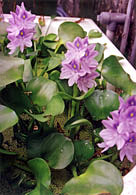
Water hyacinth flowers in the Beach House bathtub pond (Keith Addison)
The true contents of the Beach House fish pond:
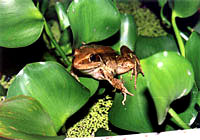
Frogs love our fish pond (Keith Addison)
More about ponds, including how to build one: Garden pond, Aquaculture for small farmers.
More about frogs: visit Frogland -- this is a great website, full of fun and whackiness, and frogs, lots of frogs.
http://allaboutfrogs.org/froglnd.shtml
Weedkiller Makes Male Frogs Into Females , Washington, Apr 15, 2002 (Reuters) -- The most popular weedkiller in the United States can give male frogs female sex organs and other attributes, researchers said, in a study that could shed light on the global decline in amphibian populations. Very low levels of the herbicide atrazine can cause male frogs to grow female sex organs and curtail their croaks -- key to attracting mates in the frog world -- a team at the University of California Berkeley found.
http://www.planetark.org/dailynewsstory.cfm/newsid/15506/story.htm
Amphibians facing global decline, BBC News, 12 April, 2000 -- Evidence shows amphibians have been in decline globally for the last half-century, say researchers. They say their work provides conclusive proof of the decline of amphibians, which include frogs, toads, newts and salamanders. More than 200 scientists contributed data from 37 countries, covering 157 species from 21 families. The studies range from two to 31 years in duration. "The decline is yet another indicator of the long-term decline in biodiversity on this planet."
http://news.bbc.co.uk/hi/english/sci/tech/newsid_709000/709368.stm
Let's hear it from the frogs! -- WWF International, 21 February, 2002: Worldwide, disturbing reports of population declines, mass mortalities and species extinctions of amphibians have been accumulating for the last two decades, so much so that the World Conservation Union (IUCN) has established a Declining Amphibian Populations Task Force. On a global scale, South Africa has high amphibian diversity, but 23 of the nation’s frog species (or 21%) are Red Data listed -- either threatened with extinction or are likely to become threatened in the near future.
http://panda.org/news/press/news.cfm?id=2739
What are weeds?
There's hardly a weed that someone hates which someone else doesn't think is the most wonderfully useful plant.
Case study
Gardeners and farmers hate quack grass, or couch grass -- yet another of the many plants called "the world's worst weed". Here's what farmers think of quack grass:
"One of the worst pests with which the farmer has to contend, taking possession of cultivated ground and crowding out valuable crops."
And here's what the famed herbalist Nicholas Culpeper said about it:
"Although a gardener be of another opinion, yet a physician holds half an acre of them to be worth five acres of carrots twice told over."
More about quack grass: hate it and fight it, or eat it, make tea out of it, cure kidney troubles with it, grind it to flour and bake bread out of it, feed it to livestock, and more.
To understand the nature and role of "weeds" and "pests", see Organic gardening -- Why organic? and Small farms -- Controlling weeds and pests.Pond weeds
"the plant of the future"
"the Golden Weed"
"the answer to deforestation and pollution"Water hyacinth
Villagers in Bangladesh clear water hyacinth from the ponds and rivers and pile it on the banks to compost -- water hyacinth will compost all by itself. Then they plant vegetables in the compost piles.
The first person to recognize the full potential of water hyacinth (Eichhornia crassipes) was the brilliant agricultural scientist Sir Albert Howard, founder of the organic farming movement, while working in India in the 1920s.
He proposed using it for purifying sewage effluent. Later tests found that an acre of water hyacinth could remove 2.4 tons of ammonium sulphate (nitrogen fertilizer) in one hour, and phosphorus just as efficiently. (More recent work has found that it can also remove toxic heavy metal pollutants.)
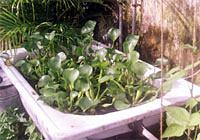
Water hyacinth keeps the water clean (Keith Addison)
Howard found that water hyacinth is easily composted, and used as a fertilizer the compost had a vivid effect on rice yields.
"One of the greatest advances in food production in the world can be achieved by the conversion of water hyacinth first into humus and then into rice," he wrote in An Agricultural Testament. "No future rice famines in Bengal need be feared once full use is made of the vast local supplies of water hyacinth."
But it's still regarded as the worst aquatic weed in the world. It recently featured as PEST CABweb's "Pest of the Month". Attempts to control it with chemicals have failed (International Water Hyacinth Consortium, Washington, DC, March 1997) and caused further problems of chemical pollution.
Others take a different view. Water hyacinth is the potential solution to the man-caused soil erosion that makes the hyacinth spread so fast and do so much damage in the first place, according to ZERI (Zero Emissions Research Initiative).
And in the US the City of San Diego uses water hyacinth to clean the pollutants out of 1,200,000 gallons of waste water a day, including toxic heavy metals. Then they compost the water hyacinth and use it as a fertilizer -- what Sir Albert Howard proposed 70 years ago.
See "The Water-Hyacinth: A Cinderella of the Plant World -- Its use in sewage effluents, as a trapper of salts and a water purifier", by G. C. Dymond, A.R.I.C.
Water hyacinth references
Duckweed
It's called duckweed because ducks eat it. So get more ducks! In Vietnam duckweed is an essential part of an integrated rice-ducks-fish farming system: scavenging ducks are used to control insects and weeds in the rice fields and are fed duckweed growing in the fields, which is also used as a high-quality feed for fish.
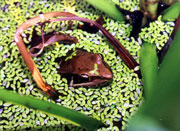
Duckweed in our pond -- another promising pest! (Keith Addison)
Duckweed reproduces by budding, and it grows fast: "At the end of 4 months this would result in about 1 nonillion plants (1 followed by 30 zeros) occupying a total volume roughly equivalent to the planet earth!" says Wayne P. Armstrong at Palomar College.
"Duckweed produces more protein per square meter than soybeans," says Louis Landesman at the University of Southwestern Louisiana.
PRISM-USA calls it an "under-utilized family of plants both as animal feed and as a natural wastewater treatment technology".
The Worldwatch Institute says it's an efficient, low-cost water purifier. And NASA wants to use it in life support systems in space.
Duckweed references
Water hyacinth references
Weed crisis: "Many African waterways are facing a crisis through the rapid spread of water hyacinth over the past two decades, and have concluded that the current strategies of chemical and mechanical control have failed in most instances. European Union countries have informed countries around Lake Victoria that they will not continue to purchase Nile perch, a major export earner for the region, if herbicides continue to be used to control water hyacinth. The African countries can no longer afford to use chemical or mechanical control as the basis for attempting to manage water hyacinth." -- Proceedings of the International Water Hyacinth Consortium, World Bank, Washington, DC, 18-19 March 1997
"The water hyacinth weed mainly thrives in water bodies surrounded by habitats experiencing excessive grazing and erosion of top soil, excessive use of agricultural fertilizers, and excessive deforestation, all caused by Man. The real long term solution to the water hyacinth weed problem, is to stop the soil erosion; to recover the mineral nutrients in the tissues of water hyacinth by promoting the use of the weed as an agro-fertilizer, as a livestock feed supplement, and as a source of other value-added products. On the utilization of water hyacinth as a resource, we must make peace with it, and stop declaring war against it." -- ZERI (Zero Emissions Research Initiative) info@zeri.org, based on "A new hope for Africa", Keto Mshigeni (editor) kmshigeni@unam.na, 1998, University of Namibia, ISBN 0947433899
See "The Water-Hyacinth: A Cinderella of the Plant World -- Its use in sewage effluents, as a trapper of salts and a water purifier", by G. C. Dymond, A.R.I.C.
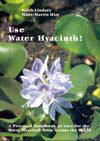 "Use Water Hyacinth!", by Keith Lindsey, Hans-martin Hirt, 1999 -- "The water hyacinth -- a beautiful flower, a noxious weed, or an absolutely free source of biomass? We, the authors of this book, believe that the water hyacinth can, and should, be used to advantage! Throughout the tropics, the words water hyacinth mean crisis. It has led to impure drinking water, prevented fishing, choked waterways, and even resulted in starvation. But maybe, in spite of everything, this horrendous weed presents a remarkable opportunity. This book is written in the belief that the water hyacinth, which grows at a phenomenal rate, can be used by people living throughout the tropics to increase their self-reliance, the quality of their diet and their general prosperity." The problems, the solutions, the uses of this amazing plant -- as fertilizer, as animal feed, for rope, crafts and furniture, as fuel, for paper and boards, other village-scale uses (eg soap-making), larger-scale and industrial utilization, simple equipment and techniques. From ECHO's Global Bookstore:
"Use Water Hyacinth!", by Keith Lindsey, Hans-martin Hirt, 1999 -- "The water hyacinth -- a beautiful flower, a noxious weed, or an absolutely free source of biomass? We, the authors of this book, believe that the water hyacinth can, and should, be used to advantage! Throughout the tropics, the words water hyacinth mean crisis. It has led to impure drinking water, prevented fishing, choked waterways, and even resulted in starvation. But maybe, in spite of everything, this horrendous weed presents a remarkable opportunity. This book is written in the belief that the water hyacinth, which grows at a phenomenal rate, can be used by people living throughout the tropics to increase their self-reliance, the quality of their diet and their general prosperity." The problems, the solutions, the uses of this amazing plant -- as fertilizer, as animal feed, for rope, crafts and furniture, as fuel, for paper and boards, other village-scale uses (eg soap-making), larger-scale and industrial utilization, simple equipment and techniques. From ECHO's Global Bookstore:
http://www.echotech.org/bookstore/
From the Water Garden Shop: Water Hyacinth: Excellent water purifier and algae preventative, $3.50
http://st7.yahoo.net/thewatergardenshop/waterhyacinth.html
"Water hyacinth is the plant of the future because of its amazing versatility. Frequently used to purify ponds, this South American native provides an ideal fish spawning ground among its long, purplish root masses. It can even be fed to cattle. Very prolific -- the Water Hyacinth does best when controlled in a warm water pool or tub." -- Sunset Koi Fish Farm in California
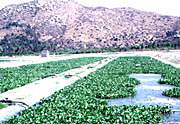 The City of San Diego uses water hyacinth to treat waste water at its San Pasqual Aquatic Treatment Facility, then composts the water hyacinth. "The San Pasqual Aquatic Treatment Facility is a constructed wetlands system using water hyacinth plants. Located in San Diego county, this facility treats 1,200,000 gallons daily of secondary sewage waste water. After treatment the water is recycled and used for sprinkler irrigation on three adjacent properties. The rapidly growing water hyacinth plants are ground to reduce volume and windrow composted to produce a clean, quality compost product useable as a mulch or soil admendment."
The City of San Diego uses water hyacinth to treat waste water at its San Pasqual Aquatic Treatment Facility, then composts the water hyacinth. "The San Pasqual Aquatic Treatment Facility is a constructed wetlands system using water hyacinth plants. Located in San Diego county, this facility treats 1,200,000 gallons daily of secondary sewage waste water. After treatment the water is recycled and used for sprinkler irrigation on three adjacent properties. The rapidly growing water hyacinth plants are ground to reduce volume and windrow composted to produce a clean, quality compost product useable as a mulch or soil admendment."
India's Ryan Foundation calls water hyacinth "a golden weed" -- it can be used to make high-quality paper, used for cattle feed, made into briquettes for villagers' cook stoves, and used to generate methane gas for cooking and heating: "not an environmental menace but an income generator. This weed must be commercialized and supplied to paper and board factories to save logging, deforestation and pollution."
Pigfeed recipe: "Boiled water hyacinth is used in Southeast Asia as a feed for pigs. The plants are chopped and sometimes mixed with other vegetable wastes, such as banana stems, and boiled slowly for a few hours until the ingredients turn into a paste, to which oil cake, rice bran and sometimes maize and salt are added. The cooked mixture is good for only three days, after which it turns sour. A common formula is 40 kg of water hyacinth, 15 kg of rice bran, 2.5 kg of fish meal and 5 kg of coconut meal." -- from "Water hyacinth, million dollar weed".
http://www.fao.org/ag/AGA/AGAP/FRG/AFRIS/Data/381.HTM
Geese for Water Hyacinth Control by B.L. Damron and H.R. Wilson, Cooperative Extension Service, Institute of Food and Agricultural Sciences, University of Florida -- The geese thrive, the water hyacinth doesn't. Simple.
http://edis.ifas.ufl.edu/BODY_PS023
Toxic heavy metals removal: "[Water hyacinth] utilizes vast amounts of many nutrients which are poisonous to humans in these amounts. The water hyacinth has been shown to remove Nitrogen and Phosphates, as well as biochemical oxygen demands. In the process of studying water hyacinth's capabilities in sewage treatment it has been discovered that this plant removes trace toxic metals as well. It's ability to remove toxic heavy metals is what makes water hyacinth so appealing for treating the water at the UMTRA Site."
http://www.geocities.com/CollegePark/Lab/9619/wahy1.html
World's Most Abundant Lake Threatened by Weeds Environment News Service, November 8, 2000 -- BLANTYRE, Malawi: The water hyacinth is choking the life out of Lake Malawi, home to the largest number of fish species of any lake in the world. Malawi's Minister for Natural Resources and Environmental Affairs, Harry Thomson, calls it "a curse to the nation and the international community". The government tried spraying chemicals but that didn't work so they took to uprooting it and burning it. But Blantyre city assembly director of leisure, culture and environment Robert Kawiya said that in Sudan, water hyacinth from the Nile River is being used in biomass energy production for cooking, lighting and refrigeration. Water hyacinth waste has been used as organic fertilizer on farms, he said, while dried hyacinth can be used for growing mushrooms. In China, the water hyacinth is a prized raw material for livestock fodder. He said poverty stricken Malawians could learn from other countries who have realized the water hyacinth's potential.
 Soobho Quality Handcrafted Products markets furniture made from water hyacinth straw -- and very eye-catching it is too. "Each item is individually handcrafted by skilled craftsmen, who have been using the same techniques of production for centuries."
Soobho Quality Handcrafted Products markets furniture made from water hyacinth straw -- and very eye-catching it is too. "Each item is individually handcrafted by skilled craftsmen, who have been using the same techniques of production for centuries."
http://soobho.com/ABOUT.HTM
Kinetic Studies of Biogas Evolved from Water Hyacinth, by F. Shoeb, H .J. Singh, Gorakhpur, India: AGROENVIRON 2000, 2nd International Symposium on New Technologies for Environmental Monitoring and Agro Applications, October 2000, Turkey -- Better than cow dung. 5,000-word paper.
http://www.green-trust.org/2000/biofuel/KineticStudies.htm
Water hyacinths: turning a weed into a win-win situation -- In Thailand, this former waterway pest is fueling agriculture, exports - and more research. Note the word "former" -- the stuff is so useful they run out of it and have to bring it in from other areas. The perfect medium to cultivate valuable straw mushrooms -- for fiber board for construction -- an ideal component in fertilizer -- wickerwork for export made from the stems: water hyacinth is actually being cultivated to produce the long stems that are best for wickerwork -- methane gas production -- 'green fuel': water hyacinth compacted into cooking wood.
http://www.angkor.com/cityrain/Ron/ff/Water%20hyacinths
%20turning%20a%20weed%20into%20a%20win-win%20situation.htm
"Water hyacinth -- Use it!": Water hyacinth can be very helpful in meeting some of the most urgent needs in tropical countries: in food production; as leaf protein concentrate, which is rich in protein and vitamin A; as a substrate for mushroom cultivation; by making soils more fertile which yield better crops; by purifying water, in which fish can then thrive; through the production of silage, for fattening animals; through vermiculture, producing feed for poultry or fish; in regenerating degraded soils; as mulch; as compost; as fertiliser, produced by mixing with other organic materials, and phosphate rock.; in energy production, thereby combatting deforestation; as biogas, which can be used for cooking in kitchens for schools or restaurants; as briquettes, which can be used for cooking in place of wood; in providing employment and income, through the production and sale of a range of art papers and card, crafts and furniture, chemicals and liquid fuels. Utilisation makes economic and social sense. -- anamed, Germany.
http://anamed.y2z.de/English_Home_Page/
Water_Hyacinth/body_water_hyacinth.html
Use Water Hyacinth! -- A Practical Handbook of Uses for Water Hyacinth from Across the World, by Keith Lindsey and Hans-Martin Hirt, January 2000
http://anamed.y2z.de/English_Home_Page/
Water_Hyacinth/Use_Water_Hyacinth_/use_water_hyacinth_.htmlDuckweed references
-- Duckweed produces more protein per square meter than soybeans
-- Duckweed is easier to harvest than algae or other aquatic plants
-- Duckweed can be used to feed fish, poultry and cattle
-- Duckweed can purify and concentrate nutrients from wastewater (sewage effluent)
-- Duckweed provides food for wildlife, especially waterfowl."
http://www.geocities.com/RainForest/Canopy/3631/
"Duckweek is low-cost water-purifier", says a Worldwatch Institute paper: "On a per-person basis, it takes two square meters of duckweed per person to do the purifying." Worldwatch Institute:
http://www.worldwatch.org/
PRISM-USA's Duckweed Clearinghouse "provides a single, comprehensive source of information on the duckweeds (Lemnaceae), especially practical knowledge about the cultivation of this under-utilized family of plants and their use both as animal feed and as a natural wastewater treatment technology." Annotated Abstracts, Full Text Publications, Project Reports, Other Sites.

Harvesting fish from an integrated duckweed-fish farm in Bangladesh (PRISM)
http://www.prism-usa.org/
The Charms of Duckweed -- Practical Duckweed -- Large collection of well-organized annotated links to research papers and project reports on "the plant for the 21st century" in action. Lots of good information on duckweed here.
http://www.mobot.org/jwcross/duckweed/
"Its astronomical vegetative growth and the ability of some species to grow in stagnant, polluted water is why some duckweeds are well suited for water reclamation. Some species not only thrive on manure-rich water, but can be fed back to livestock, thus completing the recycling process. In addition, some species (such as Wolffia) are a potential source of food for humans because they contain about 40 percent protein (dry weight) and are equivalent to soybeans in their amino acid content (with high levels of all essential amino acids except methionine)." -- Lemnaceae (Duckweed Family), maintained by Wayne P. Armstrong at Palomar College.
http://daphne.palomar.edu/wayne/1wayindx.htm
"Trials on using duckweed cultivated as a partial or complete replacement of protein supplement for feeding crossbred and Muscovy ducks gave encouraging results. The practise of using scavenging ducks to control insects and weeds in the rice fields contributes to decreased investment and brings more benefits for the farmers. Duckweed grown in the integrated farming system is also a high-quality feed for fish." -- "The Role of Scavenging Ducks, Duckweed and Fish in Integrated Farming Systems in Vietnam" Bui Xuan Men, Faculty of Agriculture, Cantho University, Vietnam.
http://www.fao.org/ag/aga/agap/frg/conf96.htm/men.htm
Duckweed Research from NASA, on the NASA Technical Reports Server: "The effects of simulated weightlessness on the reproductive capacity of the great duckweed in the norm and under irradiation," Jan 01, 1978; "Natural systems for wastewater treatment and water reuse for space and earthly applications," Jan 01, 1987.
"Duckweed -- a potential high-protein feed resource for domestic animals and fish", by R.A. Leng, J.H. Stambolie and R. Bell, Centre for Duckweed Research & Development University of New England Armidale, NSW Australia, Livestock Research for Rural Development, Volume 7, Number 1, October 1995 -- "... duckweeds yield 10-30 ton DM/ha/year (dry matter per hectare per year) containing up to 43% crude protein, 5% lipids and a highly digestible dry matter. Duckweeds have been fed to animals and fish to complement diets, largely to provide a protein of high biological value. Fish production can be stimulated by feeding duckweed to the extent that yields can be increased from a few hundred kilograms per hectare/year to 10 tonnes/ha/year."
http://www.cipav.org.co/lrrd/lrrd7/1/3.htm
The Integrated Tilapia & Duckweed Farming System -- The fish and the waters of the tilapia growout ponds provide the nutrients upon which the duckweed will thrive. In turn, the duckweed removes unwanted nutrients and waste products from the system, converting the nutrients into plant biomass. This plant biomass, in turn, becomes a high protein food for the tilapias. While all this is going on, water within the integrated system is conserved and purified. The entire system is a natural and sustainable approach to aquaculture.
http://www.fishfarming.com/recirc.html
Duckweed Aquaculture -- A New Aquatic Farming System for Developing Countries, Paul Skillicorn, William Spira & William Journey, (1993) The World Bank -- "The PRISM Group initiated a pilot project in Bangladesh to develop farming systems for duckweed and to test its value as a fish feed. The results of the pilot operations were extremely promising; production of duckweed-fed carp far exceeded expectations, and dried duckweed meal provided an excellent substitute for soy and fish meals in poultry feeds. Duckweed could be grown using wastewater for nutrients, or alternatively using commercial fertilizers. Duckweed-fed fish production does not depend on mechanical aeration and appears to be significantly more productive and easier to manage than traditional pond fish culture processes." Full text online:
http://www.prismusa.homestead.com/files/Duckweed.htm
Color photos by Gregory D. Rose
http://www.fes.uwaterloo.ca/u/gdrose/image/prism.html